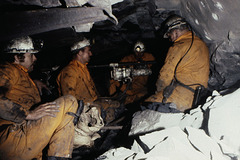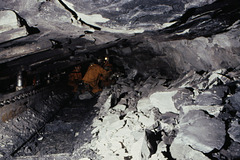
Sedimentary structures
Folder: Geology and Earth Science
Photos illustrating sedimentary structures such as cross-bedding, ripples, channels, unconformities, etc.
A bit of Burbage Edge
Another bit of Burbage Edge
Ringing Roger
| |
|
Ringing Roger is an out-thrusting ridge of gritstone tors overlooking Edale on the south margin of the Kinder plateau.
There is a good path up the ridge with an easy scramble to finish which I think is a much better and quieter route up to the plateau than the slog up Grindsbrook.
Orgreave S24's washout (3 of 3)
| |
|
This short sequence of three photographs is a rare chance to see how adverse geological conditions affected a (relatively) modern longwall face. They were taken on 2nd May 1980 at Orgreave Colliery, near Sheffield, South Yorkshire.
Please note that I did not take these photographs. They were taken by my colleague Jim Batty who was the NCB area photographer for South Yorkshire. I have used these on many an occasion to illustrate geology lectures and I am most grateful to him.
Photo 3: A closer view showing the small drilling machine boring the holes for shot firing. You can see previously drilled holes ready to be loaded with explosives.
This sort of situation caused extensive delays to production, and the difficult and, at times, unstable, roof conditions added to the risk of accident and injury on the face, although fortunately as far as I know, there were no serious incidents on this face (a wonder).
This whole washout area was around 20 - 30 metres wide from one side to the other, on a coal face that was about 180 metres wide. Eventually the washout sandstone lifted clear of the coal and production was able to be resumed relatively normally, although there were still roof control problems on this face for much of its life.
It was these sorts of conditions coupled with the fact that there was nowhere else left to work underground that led to the inevitable closure of Orgreave the following year.
Orgreave S24's washout (2 of 3)
| |
|
This short sequence of three photographs is a rare chance to see how adverse geological conditions affected a (relatively) modern longwall face. They were taken on 2nd May 1980 at Orgreave Colliery, near Sheffield, South Yorkshire.
Please note that I did not take these photographs. They were taken by my colleague Jim Batty who was the NCB area photographer for South Yorkshire. I have used these on many an occasion to illustrate geology lectures and I am most grateful to him.
Photo 2: A view looking along Orgreave S24's face in the Swallow Wood seam. The coal seam which was on the right has now been replaced by "washout" sandstone (light grey in colour). This is much too hard and strong for the normal coal cutting machine to cut through, and there would in any case have been the risk of hot frictional sparking causing ignition of any methane that might be present.
Instead, the sandstone has to be bored and broken down by firing with permitted explosives. That is what the men in the distance are doing. Previously fired-down sandstone is visible to the right of centre and the whole situation resembles an underground stone quarry rather than a proper longwall coal face.
Orgreave S24's washout (1 of 3)
| |
|
This short sequence of three photographs is a rare chance to see how adverse geological conditions affected a (relatively) modern longwall face. They were taken on 2nd May 1980 at Orgreave Colliery, near Sheffield, South Yorkshire.
Please note that I did not take these photographs. They were taken by my colleague Jim Batty who was the NCB area photographer for South Yorkshire. I have used these on many an occasion to illustrate geology lectures and I am most grateful to him.
Photo 1: A view looking along Orgreave S24's face in the Swallow Wood seam. The coal seam is on the right, the banks of hydraulic powered roof supports are on the left. The normal travelling way (a crawl!) is beneath this canopy of supports. In the centre leading away into the distance is the armoured steel conveyor (the 'panzer'). You can also see the sprocket chain that coal cutting machine (not visible here) used to haul itself along the top of the conveyor.
This particular coal face operated in the year before the mine closed, and it was beset with geological difficulties, which were suspected in advance, and that's why this particular patch of coal was one of the very last to be worked.
The main problem was the irregular, undulating sandstone roof. In essence, the coal was worked beneath a complex 'fossil' river channel system, where sand originally deposited by the rivers fills in the channels and eventually gets turned into sandstone. In this photo the sandstone is pale grey and sits fairly evenly on top of the coal. But it is already breaking into large lumps and falling out prematurely. Further on, in photos 2 and 3, the river has cut down more deeply and eroded away the vegetation that was to eventually become coal, causing a 'washout'.
It was part of my job to map these channel features and to try to predict what they would do next. So I spent a lot of time on this particular face. I remember it very well indeed.
Valkyrie Pinnacle - a tor on Froggatt Edge
| |
|
|
'Valkyrie Pinnacle' - a tor of cross-bedded Chatsworth Grit on Froggatt Edge, overlooking the Derwent Valley. Derbyshire, England.
Hunstanton Red Cliffs
| |
|
|
|
Cliffs at Hunstanton, Norfolk, UK, illuminated by the late afternoon sun shining through shower clouds offshore. This is probably the best exposure of the Red Chalk in the UK.
The top-to-bottom sequence is:
Cenomanian (White) Chalk
-- disconformity -- (~ 2 million year time gap)
Hunstanton Formation ('Red Chalk')
Carstone Formation ('Lower Greensand' - brown!)
Lower Greensand
| |
|
|
|
Textures in the Lower Greensand, exposed in the cliffs at Hunstanton, Norfolk, UK.
Jump to top
RSS feed- Latest items - Subscribe to the latest items added to this album
- ipernity © 2007-2024
- Help & Contact
|
Club news
|
About ipernity
|
History |
ipernity Club & Prices |
Guide of good conduct
Donate | Group guidelines | Privacy policy | Terms of use | Statutes | In memoria -
Facebook
Twitter









